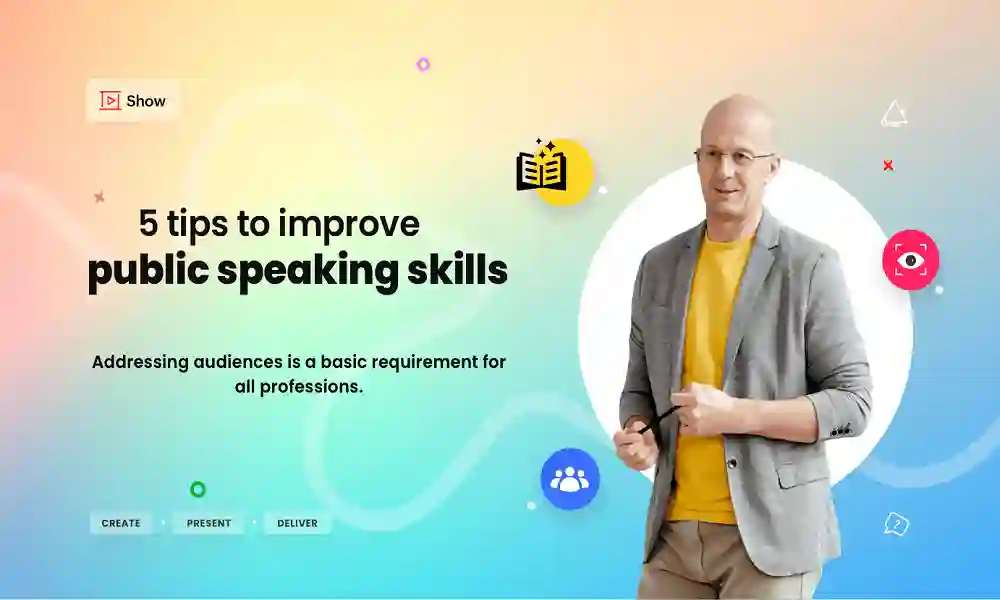How to Improve Your Public Speaking with Simple Tips

Public speaking. It’s the thing we dread—until we realize it’s the key to getting noticed in a room full of people. At some point, we all find ourselves standing in front of an audience, whether for a presentation, a toast, or gulp, a pitch. The good news? It doesn’t have to be a nightmare. You can absolutely improve your public speaking skills, and no, you don’t need to be born with a microphone in hand to do it. Let’s get into how you can kick those nerves to the curb and make a lasting impression.
Understanding the Importance of Public Speaking
Before diving into how to improve your public speaking, let’s back up a second. You’re probably wondering: why does this even matter? Well, turns out, public speaking isn’t just for motivational speakers or politicians. It’s for everyone. Whether you’re sharing an idea at work, giving a wedding toast, or presenting a project in class, the ability to speak well in front of others is way more important than we give it credit for.
Why Does Public Speaking Matter?
Let me break it down. The truth is, good public speaking gives you power. And I’m not just talking about the ability to make a great impression (though, duh, that’s huge). When you get better at speaking in public, you:
- Look like a boss. Seriously, confidence shines through when you speak clearly and with purpose.
- Lead like a pro. Public speaking is directly linked to leadership. If you can articulate ideas, people will follow.
- Connect with people. Ever heard of the phrase “It’s not what you say, it’s how you say it?” Yeah, that’s real. The way you speak can build relationships.
- Stand out. Whether you’re advocating for your big idea or pitching yourself in an interview, great public speaking helps you rise above the crowd.
Okay, I’m done preaching. But if you still have doubts about the power of public speaking, I’ll just tell you this: It’s like holding a microphone to your future. You control how loud the world hears you. So let’s figure out how to hold that mic like a pro.
1. Know Your Audience
Okay, so imagine you’re getting up to speak. Do you know who you’re talking to? Do you? It’s easy to assume your message will hit home with everyone, but not all audiences are the same. You wouldn’t pitch a comedy show to a room full of retirees at a nursing home, right? You gotta know the vibe.
Tailor Your Message
I learned the hard way: speaking to a room full of introverts about how to socialize is like speaking to a bunch of cat owners about how to not love cats. It’s weird. So, you gotta do your homework.
- Research: Don’t just go in blind. Learn a bit about your audience. Are they into tech? Artsy? Do they know what a “pivot table” is, or will they fall asleep faster than I could ever say “Excel”? (Trust me, I’ve seen it.)
- Gauge their interests: You know, figure out what they care about. If you’re talking to a group of gardeners, don’t spend 10 minutes on the stock market. It’s a surefire way to lose their attention.
- Anticipate their needs: What do they want from you? Clear takeaways? A laugh? A personal connection? Give ’em what they want, and you’ll win ’em over.
This isn’t just fluff. It makes all the difference in how your speech lands. Trust me, I once gave a “passionate” speech on SEO strategies to a room of senior citizens, and… well, I was very alone in that room. Learn from my mistakes, y’all.
2. Practice, Practice, Practice
I mean, yeah, it’s obvious, but let’s be real. You can’t just show up and expect your speech to magically fall into place. Nope, practice is non-negotiable.
Rehearse Like a Pro
For me, rehearsing in front of a mirror has been a game-changer. I’m not even kidding. You can see what your body’s doing, and trust me—your body says a lot. No one wants to be the person giving a speech while awkwardly shifting from one foot to another like they’re waiting for a bus.
- Mirror practice: Look at yourself. Don’t be shy. Watch your gestures, your facial expressions. Make sure you’re not coming off as “I’m the nervous person trying to fake confidence.” (Trust me, you’ll know when you’re doing it.)
- Record yourself: This one’s tough, but it’s worth it. I’d often cringe listening to myself, but hey—it helps. You can catch things like awkward pauses or saying “uh” too much. (And if you’re guilty of it like I am, hey, I get you.)
- Rehearse with people: Maybe you’ve got a roommate, a friend, or even a family member who can act as your audience. Grab ‘em! They’ll give feedback, and you’ll feel way less nervous the next time you step in front of a crowd.
Fast forward past my first five disastrous attempts, and voilà! I became 1% less terrified to speak in public. It’s the little wins.
3. Work on Your Body Language
So, get this. You could have the best speech in the world, but if your body language is as stiff as a cardboard cutout, no one’s going to care. And by “no one,” I mean literally anyone.
The Power of Body Language
Remember: You can say all the right things, but if you’re standing there with your arms crossed like you’re about to be judged for a grocery store meltdown, it sends the wrong message. Body language is a BIG deal.
- Stand tall: Look, posture matters. You want to appear confident, not like you’re about to crawl into a hole. Shoulders back, feet planted, like you’re ready to conquer the world.
- Hand gestures: I used to be super self-conscious about my hand gestures, but now? They help emphasize points and actually engage the audience. I’m not saying you should be waving your arms around like a windmill, but a little bit of motion goes a long way.
- Eye contact: It’s huge. Not in a creepy, I-know-what-you’re-thinking way. Just steady, confident eye contact that shows you’re connected to your audience.
This might sound like basic stuff, but trust me. The first time I gave a speech and didn’t fiddle with my notes or shuffle my feet, I felt like I had unlocked some level of speaking Zen.
4. Speak Clearly, But Don’t Overthink It
Here’s the thing about public speaking: clarity is your best friend. You could have all these amazing ideas, but if they’re muddled with jargon, confusing language, or a ton of filler words? Not gonna land. Keep it simple.
Keep It Clear
You need to focus on two things:
- Enunciation: Speak clearly. Pronounce those words like you’re not secretly trying to mumble your way through an awkward silence. (I’ve been there.)
- Cut the filler words: Yeah, “um” is cute for a second, but a whole speech filled with “um” is like… watching paint dry. Stop it before it starts.
And I’ll admit, my first few speeches? I did all the wrong things. Rambling? Check. Over-explaining? You bet. Filler words? My specialty. If only I’d known that less was more.
5. Manage Those Nerves
Here’s the kicker. Everyone gets nervous. Every. Single. Person. Heck, I still feel it. But it’s what you do with that nervous energy that makes all the difference.
Calm Your Nerves
I’ve tried everything. Deep breathing. Visualization. Pretending the audience is a bunch of chickens. Nothing works 100%. But here’s what does:
- Practice relaxation: Try breathing exercises before you go on stage. It sounds cheesy, but it really calms the nerves.
- Visualize success: Picture yourself owning that stage. It might sound like motivational poster material, but seriously—it works.
- Shift your focus: Don’t focus on your fear. Focus on delivering the message. The more you get wrapped up in your fear of speaking, the worse it gets.
Oh, and here’s a pro tip: If you get nervous, it’s okay. Just breathe, let it go, and keep going. Even the greats have their “uh-oh” moments. I mean, did you hear how I butchered my first wedding toast? A little sweat never hurt anybody.
6. Engage Your Audience
Audience engagement is like the secret sauce of public speaking. You want them to feel like they’re in this with you, not like they’re watching a one-person show.
How to Get Them Involved
- Ask questions: Engage them. Don’t just spew facts. Ask questions, make them think, even get them to laugh. Trust me, people will remember you better.
- Share stories: People remember stories. So, tell them. A personal anecdote or funny tale can make your speech way more relatable.
- Humor: I’m not saying you need to be a stand-up comedian, but a little humor never hurt. (Unless you’re trying to make a joke about… that coworker. Don’t go there.)
You know what, though? I once made a joke about my pet iguana during a presentation and—awkward silence. You’ll get it right eventually. And if you don’t? Own it. Laugh with the crowd. They’ll appreciate it.
Conclusion: Keep Improving
Anyway, here’s the kicker. Public speaking isn’t just about getting up and saying words in front of a crowd. It’s about finding your rhythm. It’s about learning your audience, practicing until you’re smooth, and owning the stage when your moment comes. Sure, you might stumble along the way (guilty as charged), but that’s just part of the process.
So, I’ll leave you with this: Keep working on it. Keep practicing. Keep tweaking. Whether you’re speaking at work or hosting your family’s next Zoom call, these tips will help you get where you want to go. Public speaking? It gets easier. Trust me.







